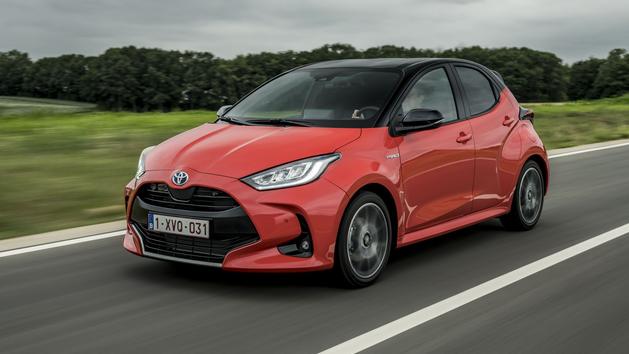There is a premium for made in France. Produced in Valenciennes, the Yaris is Toyota's most popular model in France. Since the first generation released in 1999, 500,000 copies have been sold there, including 43,000 of the third generation last year alone. With the new model, the Japanese giant intends to do at least as well. A challenge within its reach for this vehicle which not only offers significantly higher services but also benefits from a favorable context, between the State conversion premium and the attractive tax system linked to its technology. This is how the Yaris 4 inaugurates the GA-B platform dedicated to small cars (GA-B) and incorporating the principles of the TNGA structure of models in the upper segments. It is distinguished by increased rigidity, a lowered center of gravity, better weight distribution and a host of technologies, starting with a unique hybrid powertrain.
Toyota
The revolution is noticeable at first glance. The Yaris abandons its plan-plan lines for a seductive silhouette. Curved wheel arches, very short overhang, rear cutout evoking the CH-R: the city car of Hauts de France looks like a ball of nerves. A big part of the structure's ingenuity is being able to accommodate hybrid technology and superior roominess in a more compact form factor. And thanks to its extended hood and the receding cabin, the Yaris appears taller than it actually is. If it is shortened by 50 mm, it gains as much in terms of the wheelbase. The gain is sensitive to the rear seats which can easily accommodate adults. The trunk does not suffer from the new dimensions since with 283 liters, the cargo volume equals that of the Peugeot 208. Progress goes as much through the refined presentation as by the sporty atmosphere, reflecting a lowered driving position and the motorcycle-style cap housing the instrument cluster.
A central airbag to protect the occupants
Toyota
Depending on the finish, light interior and panoramic roof or sadly black trim, one has the impression of being in the presence of two very different cars. The 8-inch central screen concentrates all the functions accessible via eight shortcut keys, but it is positioned too high for our liking and the navigation system often acts late. The finish has a very plastic appearance despite the foam coating on the upper part of the board. Obviously, Toyota had other priorities. the Yaris takes itself for a big one: color head-up display, driving assistance systems, some of which are really intrusive - adaptive cruise control, sign reader, lane departure warning coupled with the path corrector, pedestrian detection and cyclists as well as traffic at intersections - and, this is a first for this range, central airbags as standard. They prevent the occupants of the front seats from colliding in the event of a side impact.
The revolution continues under the hood with a transfigured hybrid engine. Derived from the 2-liter 4-cylinder from the Corolla, the heat engine is still a 1.5-liter but has lost a cylinder. It delivers 91 hp and 120 Nm, instead of 77 hp and 111 Nm for the previous generation. Two electric motors complete the device: the first is used to start the engine and charge the battery; the second of 79 hp provides electric propulsion. The power comes out at 116 hp. Lithium-ion type instead of nickel-metal-hydride, the battery guarantees faster recharge cycles. This is how we can drive 80% electric in town, on condition of always accelerating smoothly but up to higher speeds, of the order of 70 km / h. We are amazed at the incessant flow of energies. You can force the EV mode to enter a low emission zone, but it is best to let the system operate. When the batteries are empty, the 3-cylinder raises the tone for a few seconds. It is also possible to switch the selector of the continuously variable transmission to mode B, increasing the engine brake and thereby generating greater regeneration. If we did not succeed in reproducing the consumption of 3.8 l / 100 km claimed by Toyota, during the crossing of Brussels, the computer displayed a flattering 4.3 l / 100 km. As soon as you take a fast lane, you quickly climb to 4.7 l / 100 km, enough to ensure a range of nearly 750 km. In the flow of traffic, the Yaris struggles a bit when it comes to overtaking or restarting, despite more vigorous acceleration (0 to 100 km / h in 10.3 seconds). These performances, this is undoubtedly the main benefit of this Yaris, are accompanied by a lowered noise level and a virtual disappearance of the throbbing slip phenomenon of the previous model. In the field of approval, the Renault Clio hybrid E-Tech however keeps the advantage with its clutch transmission. This is also the case in the field of road handling even if the Yaris does not have to be ashamed with a markedly improved agility and comfort. Electric power steering, however, deserves a higher force feedback.
Our opinion
The Yaris is unrecognizable. More successful than ever, the Japanese city car produced in France is now armed to defend its place in the face of increased competition with the arrival of the Renault Clio E-Tech and the Honda Jazz. The Yaris can claim Toyota's reputation for reliability and a well-positioned price tag. From € 20,950 in the French version.

